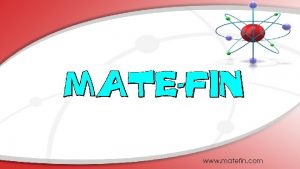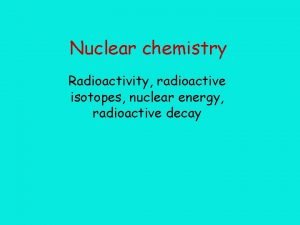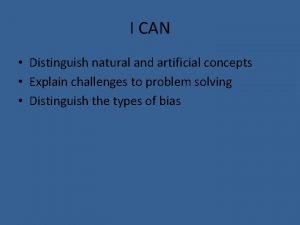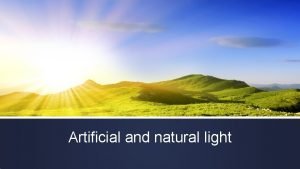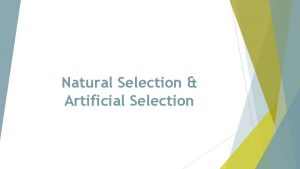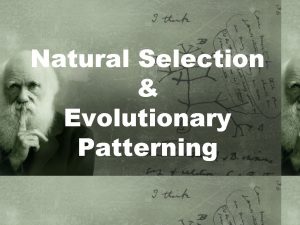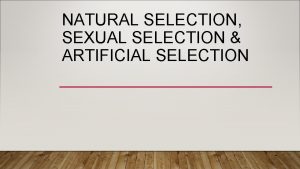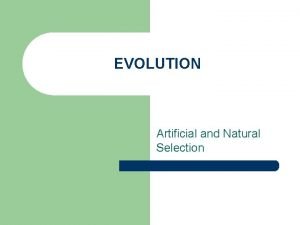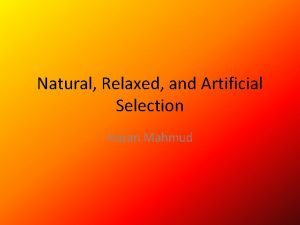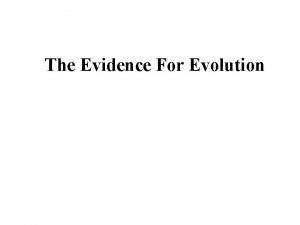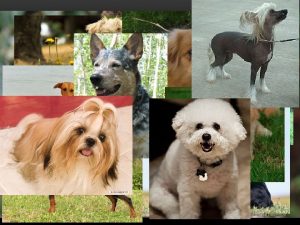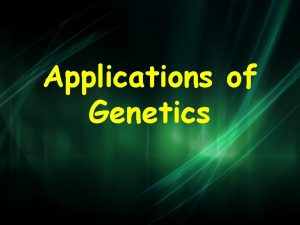7 2 NATURAL SELECTION AND ARTIFICIAL SELECTION See











- Slides: 11

7. 2 NATURAL SELECTION AND ARTIFICIAL SELECTION See pages 305 – 310 of your textbook

NATURAL SELECTION This is the process that results when the characteristics of a population of organisms change over many generations. This change happens because INDIVIDUALS with certain inherited traits survive and reproduce, passing on their alleles to their offspring. For this to happen, there must be DIVERSITY (different alleles) in the population.

SELECTIVE PRESSURE When the environment changes, those individuals with alleles that allow them to survive and reproduce will be “selected for” by the environment. Those individuals that lack the required characteristics that would allow them to survive will die, and their genes will not be available in the population. These individuals are “selected against” by the environment. These selective pressures from the environment can be abiotic or biotic.

NATURAL SELECTION IS SITUATIONAL!! Think of the peppered moth example. In the preindustrial environment, the allele for dark wings was selected against by the environment. As the environment changed, the allele for dark wings was selected for. A trait that at one time and in one situation is helpful will survive and be passed on to offspring. If the environment changes, a trait that was previously nonbeneficial may then become helpful.

FITNESS A organism that exhibits “fitness” to its environment is one that is able to survive and pass its advantageous genes on to the population’s gene pool. The more viable offspring that an individual produces, the higher that individuals level of fitness.

ARTIFICIAL SELECTION Darwin studied the effects that humans can have on the evolution of race horses. The fastest and strongest horses were selectively bred to produce faster and stronger offspring. Whenever a human exerts selective pressure on a population in order to improve or modify particular desirable traits, this is known as artificial selection.

ARTIFICIAL SELECTION Artificial selection has resulted in our ability to modify organisms we use for food production. We select and breed plants and animals in order to maximize the quality and quantity of crop or animal product that we can obtain from them. Plants can be selectively bred to grow in specific conditions (e. g. shade grass, full sun grass). Domestic animals, like cats and dogs, can be bred to show certain desirable characteristics, like how they look or size.

ARTIFICIAL SELECTION

CONSEQUENCES OF ARTIFICIAL SELECTION In breeding organisms to exhibit one particularly desirable trait to humans, it may result in a negative impact on the target organism. Example: breeding bulldogs, pugs and Persian cats to have flat faces (a desirable physical characteristic for pet owners) results in respiratory difficulties in these animals.

CONSEQUENCES OF ARTIFICIAL SELECTION Organisms produced through artificial selection are bred to be similar. This reduces genetic diversity in the population. Agricultural practices often involve propagation of the same varieties of species over large areas. This is known as a monoculture. This makes the area easier to manage for farmers, but because all organisms are similar, if a new disease infests the population, most of the individuals will be affected in the same way.

CONSEQUENCES OF ARTIFICIAL SELECTION Gene banks have been established that contain populations of early ancestors to many modern plants. This maintains genetic combinations that have been selected against by farmers, but prevents genetic diversity from being lost. Many specimens have been collected from the wild, and from prehistoric archaeological sites.
 Artificial selection vs natural selection
Artificial selection vs natural selection Natural selection vs artificial selection
Natural selection vs artificial selection Artificial selection vs natural selection
Artificial selection vs natural selection Disruptive selection
Disruptive selection Natural selection vs artificial selection
Natural selection vs artificial selection Natural and artificial radioactivity
Natural and artificial radioactivity Artificial transmutation worksheet
Artificial transmutation worksheet Natural and artificial radioactivity
Natural and artificial radioactivity Bilateral balanced occlusion definition
Bilateral balanced occlusion definition Natural and artificial food additives
Natural and artificial food additives Metnal set
Metnal set Artificial and natural light
Artificial and natural light





